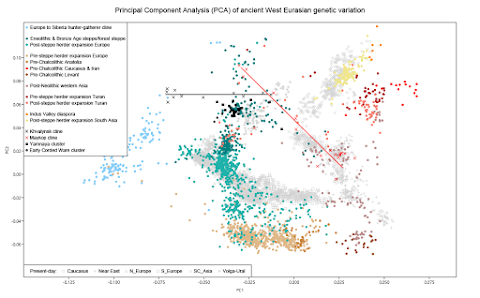In recent years you may have read academic papers, books and press articles claiming that the Early Bronze Age Yamnaya culture of the Pontic-Caspian steppe was founded by migrants from the Caucasus, Mesopotamia or even Central Asia.
Of course, none of this is true.
The Yamnaya herders and closely related groups, such as the people associated with the Corded Ware culture, expanded from the steppe between the Black and Caspian seas, and, thanks to ancient DNA, it's now certain that they were overwhelmingly derived from a population that had existed in this region since at least the mid-5th millennium BCE (see here).
So rather than being culturally advanced colonists from some Near Eastern civilization, the ancestors of the Yamnaya herders were a relatively primitive local people who still largely relied on hunting and fishing for their subsistence. They also sometimes buried their dead with flint blades and adzes, but hardly ever with metal objects, despite living in the Eneolithic epoch or the Copper Age.
As far as I know, this group doesn't have a specific name. But in recent scientific literature it's referred to as Eneolithic steppe, so let's use that.
It's not yet clear how the Yamnaya people became pastoralists. Some scholars believe that they were basically an offshoot of the cattle herding Maykop culture of the North Caucasus. However, the obvious problem with this idea is that the Yamnaya and Maykop populations probably didn't share any recent ancestry. In fact, ancient DNA shows that the former wasn't derived from the latter in any important or even discernible way (see here).
On the other hand, Yamnaya samples do harbor a subtle signal of recent gene flow from the west that appears to be most closely associated with Middle to Late Neolithic European agropastoralists (see here). Therefore, it's possible that herding was adopted by the ancestors of the Yamnaya people as a result of their sporadic contacts with populations living on the western edge of the Pontic-Caspian steppe.
Eneolithic steppe is currently represented by just three samples in the ancient DNA record, and all of these individuals are from sites on the North Caucasus Piedmont steppe (two from Progress 2 and one from Vonyuchka 1).
As a result, it might be tempting to argue that cultural, if not genetic, impulses from the Caucasus did play an important role in the formation of the Yamnaya and related peoples. However, it's important to note that the North Caucasus Piedmont steppe was the southern periphery of Eneolithic steppe territory.
Below is a map of Eneolithic steppe burial sites featured in recent scientific literature. It's based on data from Gresky et al. 2016, a paper that focused on a specific and complex type of cranial surgery or trepanation often practiced by groups associated with this archeological culture (see here).
Incredibly, one of the skeletons from Vertoletnoe pole has been radiocarbon dated to the mid-6th millennium BCE. My suspicion, however, is that this result was blown out by the so called reservoir effect (see here). In any case, the academic consensus seems to be that the roots of Eneolithic steppe should be sought in the Lower Don region, rather than in the Caucasus foothills (see page 36 here).
Considering that nine Eneolithic steppe skulls from the Lower Don were analyzed by Gresky et al., I'd say it's only a matter of time before we see the publication of genome-wide data for at least of couple of these samples. Indeed, the paper's lead author is from the Deutsches Archäologisches Institut, which is currently involved in a major archaeogenetic project on the ancient Caucasus and surrounds. Unfortunately, the study is scheduled to be completed in about four years (see here).
But whatever happens, the story of Eneolithic steppe deserves to be investigated in as much detail as possible, because it obviously had a profound impact on Europe and its people.
In my estimation, at least a third of the ancestry of present-day Northern Europeans, all the way from Ireland to the Ural Mountains in Russia, is ultimately derived from Eneolithic steppe groups. It's also possible that R1a-M417 and R1b-L51, the two most frequent Y-chromosome haplogroups in European males today, derive from a couple of Eneolithic steppe founders. If so, that's a very impressive effort for such an obscure archeological culture from what is generally regarded as a peripheral part of Europe.
See also...
search this blog
Thursday, February 13, 2020
Monday, February 3, 2020
Did Caucasus hunter-gatherers ever live in what is now Iran?
Nope, they only lived in the Caucasus Mountains. See that's probably why they're called Caucasus hunter-gatherers, or CHG for short.
But what about the hunter-gatherers from the Belt and Hotu caves in northern Iran, you might ask? Well, what about them? They're not CHG, nor are they significantly more CHG-like than the early farmers of the Zagros Mountains.
To illustrate the point, below are a couple of TreeMix graphs. I'd say they're rather straightforward and self-explanatory.
However, please note that I combined the Belt and Hotu individuals into one sample to help keep the marker count at over 100K. Also keep in mind that CHG is represented by Kotias_HG.
See also...
A final note for the year
A note on Steppe Maykop
Did South Caspian hunter-fishers really migrate to Eastern Europe?
Labels:
ancient DNA,
Belt,
Black Sea,
Caspian Sea,
Caucasus,
Caucasus hunter-gatherers,
CHG,
Georgia,
Hotu,
Hotu and Belt caves,
Iran,
Kotias,
Near East,
Satsurblia,
South Caspian,
West Asia,
Zagros Mountains
Subscribe to:
Comments (Atom)



